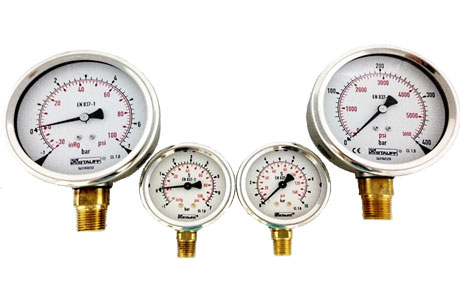What Is The Purpose Of A Vacuum Pressure Gauge?
Key Takeaway
A vacuum pressure gauge measures pressures below atmospheric pressure. It is used to monitor vacuum systems in industries like pharmaceuticals, manufacturing, and laboratories.
These gauges help ensure equipment functions correctly by maintaining the required vacuum levels. They are crucial for processes like distillation, drying, and material handling.
Defining Vacuum Pressure and Its Importance
Vacuum pressure, a concept often encountered in scientific and industrial applications, refers to a pressure lower than atmospheric pressure. It is crucial for processes that require a controlled environment, such as semiconductor manufacturing, chemical processing, and vacuum packaging. Understanding vacuum pressure and its significance is essential for optimizing these operations. The importance of vacuum pressure lies in its ability to prevent contamination, improve product quality, and enhance process efficiency.
By creating a vacuum, we can control the presence of gases and vapors, ensuring ideal conditions for sensitive processes. This introduction highlights the fundamental role of vacuum pressure in various industries, emphasizing the need for precise measurement and control to achieve desired outcomes.

Types of Vacuum Pressure Gauges
There are several types of vacuum pressure gauges, each designed for different applications:
1. Bourdon Tube Vacuum Gauges: These gauges measure vacuum by utilizing a Bourdon tube, which bends when the pressure inside a system decreases. The bending movement is translated into a reading on the gauge dial.
2. Capacitive Vacuum Gauges: These use a change in capacitance between two electrodes in response to pressure changes to measure vacuum levels.
3. Thermocouple Vacuum Gauges: These gauges measure vacuum by detecting the heat transfer between a filament and the gas molecules inside the vacuum. The more molecules present, the more heat is transferred, and this is used to calculate the pressure.
4. Piezoelectric Vacuum Gauges: These gauges measure the pressure by detecting the force applied to a piezoelectric crystal due to gas molecules colliding with it.
5. Ionization Vacuum Gauges: Used for very low vacuum levels, these gauges measure the ionization of gas molecules inside the vacuum and use this data to calculate pressure.
Applications in Industrial and Scientific Fields
Vacuum pressure gauges are widely used in a variety of fields, including:
Industrial Manufacturing: In industries like semiconductor fabrication, pharmaceuticals, and vacuum packing, maintaining and monitoring vacuum levels is crucial for quality control and product consistency.
Research Laboratories: Scientific experiments that require low-pressure environments, such as in particle accelerators or high-energy physics research, rely heavily on vacuum gauges for precise measurements.
Food Packaging: Vacuum gauges are also used in the food industry for vacuum sealing and packaging to preserve freshness and extend shelf life.
HVAC Systems: In heating, ventilation, and air conditioning systems, vacuum gauges monitor and maintain the right vacuum levels during system maintenance and repair.
Vacuum Pumps and Systems: Monitoring vacuum levels in pumps and vacuum chambers helps ensure proper functioning and detect leaks or system inefficiencies.
Benefits of Measuring Vacuum Pressure
Process Control: Measuring vacuum pressure ensures that processes, like coating or drying, occur under the right conditions, which improves product quality and process consistency.
Equipment Protection: By monitoring vacuum levels, operators can prevent damage to equipment that could occur from improper vacuum levels, such as pump failure or leaks.
Cost Efficiency: Accurate vacuum measurements can help reduce energy consumption and prevent unnecessary wear and tear on equipment, leading to longer operational lifespans.
Safety: For applications such as laboratory experiments, maintaining the correct vacuum pressure helps reduce the risk of accidents, such as implosions, when working with sensitive materials or equipment.
Limitations and Considerations in Usage
While vacuum pressure gauges are essential tools, there are a few considerations to keep in mind:
Range Limitation: Different types of vacuum gauges have limitations based on the vacuum range they can measure effectively. Some are better suited for high-vacuum applications, while others are designed for low or ultra-high vacuums.
Accuracy: Some gauges may lose accuracy in extreme vacuum conditions, requiring calibration or maintenance to ensure reliable readings.
Environmental Factors: High temperatures, humidity, or exposure to corrosive chemicals may affect the performance or longevity of certain types of vacuum pressure gauges.
Cost: More advanced gauges, such as ionization gauges, can be expensive and may require specialized calibration or maintenance.
Conclusion
A vacuum pressure gauge is specifically designed to measure pressures below atmospheric levels. Its primary purpose is to monitor and control vacuum systems, ensuring they operate within the desired parameters. These gauges play a critical role in industries such as manufacturing, research, and healthcare, where maintaining a specific vacuum level is crucial for processes like distillation, filtration, and sterilization.
Vacuum gauges are available in various types, including mechanical and digital, to suit diverse applications. In conclusion, a vacuum pressure gauge is essential for maintaining optimal performance in systems that require precise vacuum control.

